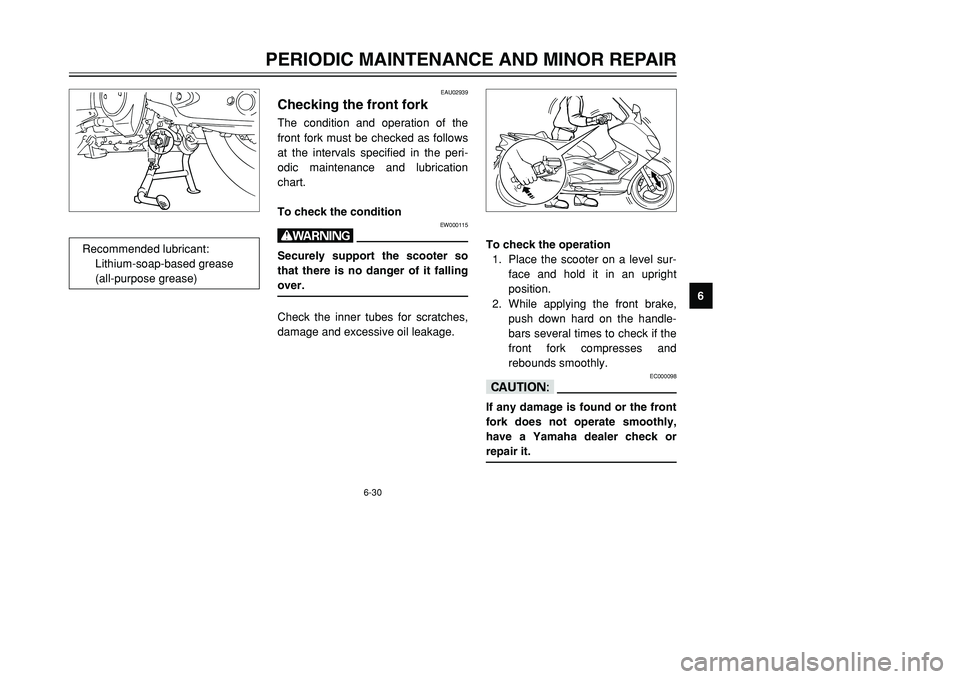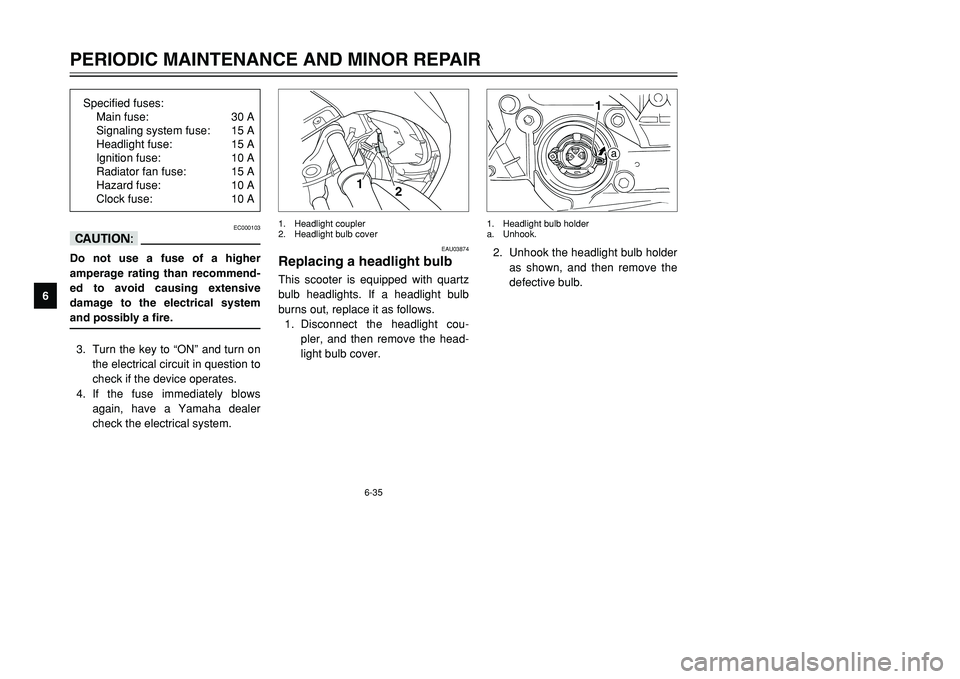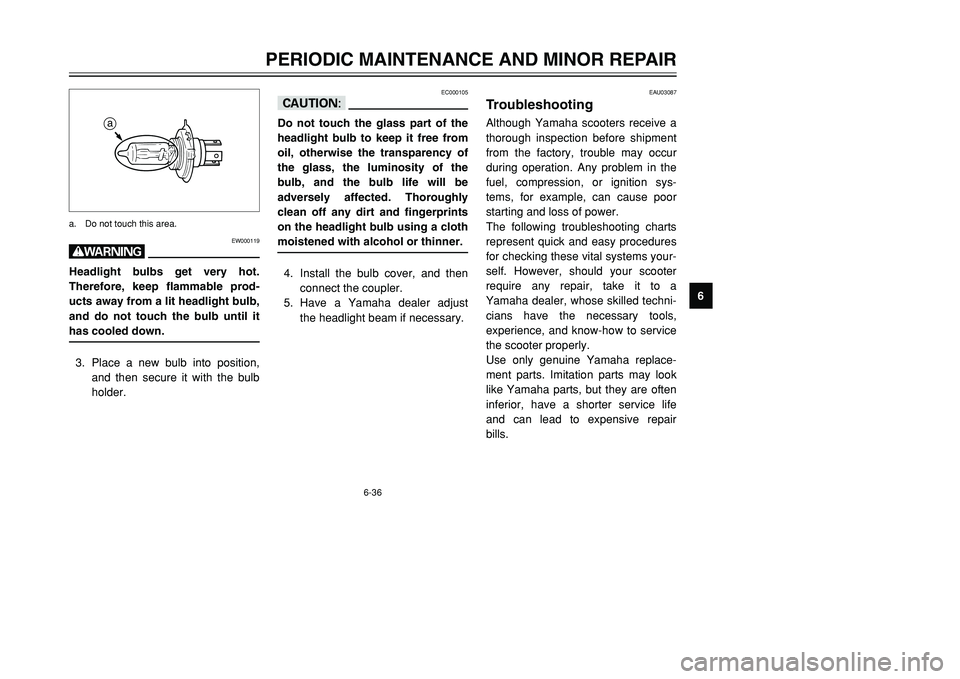YAMAHA TMAX 2002 Manual PDF
Manufacturer: YAMAHA, Model Year: 2002, Model line: TMAX, Model: YAMAHA TMAX 2002Pages: 102, PDF Size: 1.67 MB
Page 71 of 102

6-27
PERIODIC MAINTENANCE AND MINOR REPAIR
6
EAU03294
Checking the brake fluid
levelBrake fluid level, checkingInsufficient brake fluid may allow air
to enter the brake system, possibly
causing it to become ineffective.
Before riding, check that the brake
fluid is above the minimum level mark
and replenish if necessary. A low
brake fluid level may indicate worn
brake pads and/or brake system
leakage. If the brake level is low, be
sure to check the brake pads for
wear and the brake system for leak-
age.
1
1. Minimum level mark
EAU01248
Rear brake pads
1. Remove the rear brake caliper
by removing the bolts.
2. Check each rear brake pad for
damage and measure the lining
thickness. If a brake pad is dam-
aged or if the lining thickness is
less than 0.8 mm, have a
Yamaha dealer replace the
brake pads as a set.
3. Install the rear brake caliper by
installing the bolts, then tighten-
ing them to the specified torque.
a1
1. Bolt (×2)
a. Brake pad wear limit
Tightening torque:
Brake caliper bolt:
40 Nm (4.0 m·kgf)
REAR
FRONT
5GJ-9-E1 9/4/01 1:27 PM Page 70
Page 72 of 102

6-28
PERIODIC MAINTENANCE AND MINOR REPAIR
6 Observe these precautions:
8When checking the fluid level,
make sure that the top of the
brake fluid reservoir is level.
8Use only the recommended qual-
ity brake fluid, otherwise the rub-
ber seals may deteriorate, caus-
ing leakage and poor braking
performance.
1
1. Minimum level mark
EAU03976
Changing the brake fluidBrake fluid, changingHave a Yamaha dealer change the
brake fluid at the intervals specified in
the NOTE after the periodic mainte-
nance and lubrication chart. In addi-
tion, have the oil seals of the master
cylinders and calipers as well as the
brake hoses replaced at the intervals
listed below or whenever they are
damaged or leaking.
8Oil seals: Replace every two
years.
8Brake hoses: Replace every four
years. 8Refill with the same type of brake
fluid. Mixing fluids may result in a
harmful chemical reaction and
lead to poor braking perfor-
mance.
8Be careful that water does not
enter the brake fluid reservoir
when refilling. Water will signifi-
cantly lower the boiling point of
the fluid and may result in vapor
lock.
8Brake fluid may deteriorate paint-
ed surfaces or plastic parts.
Always clean up spilled fluid
immediately.
8As the brake pads wear, it is nor-
mal for the brake fluid level to
gradually go down. However, if
the brake fluid level goes down
suddenly, have a Yamaha dealer
check the cause.
REARRecommended brake fluid:
DOT 4
5GJ-9-E1 9/4/01 1:27 PM Page 71
Page 73 of 102

6-29
PERIODIC MAINTENANCE AND MINOR REPAIR
6
EAU04034
Checking and lubricating the
throttle grip and cableThrottle grip and cable, checking and lubricatingThe operation of the throttle grip
should be checked before each ride.
In addition, the cable should be lubri-
cated or replaced at the intervals
specified in the periodic maintenance
chart.
EAU03371
Checking and lubricating the
centerstand and sidestandCenterstand and sidestand, checking and lubricatingThe operation of the centerstand and
sidestand should be checked before
each ride, and the pivots and metal-
to-metal contact surfaces should be
lubricated if necessary.
EW000114
wIf the centerstand or sidestand
does not move up and down
smoothly, have a Yamaha dealer
check or repair it.
EAU03118
Lubricating the front and
rear brake leversBrake levers, lubricatingThe pivoting points of the front and
rear brake levers must be lubricated
at the intervals specified in the peri-
odic maintenance and lubrication
chart.
Recommended lubricant:
Lithium-soap-based grease
(all-purpose grease)
5GJ-9-E1 9/4/01 1:27 PM Page 72
Page 74 of 102

6-30
PERIODIC MAINTENANCE AND MINOR REPAIR
6
To check the operation
1. Place the scooter on a level sur-
face and hold it in an upright
position.
2. While applying the front brake,
push down hard on the handle-
bars several times to check if the
front fork compresses and
rebounds smoothly.
EC000098
cCIf any damage is found or the front
fork does not operate smoothly,
have a Yamaha dealer check or
repair it.
EAU02939
Checking the front forkFront fork, checkingThe condition and operation of the
front fork must be checked as follows
at the intervals specified in the peri-
odic maintenance and lubrication
chart.
To check the condition
EW000115
wSecurely support the scooter so
that there is no danger of it falling
over.Check the inner tubes for scratches,
damage and excessive oil leakage. Recommended lubricant:
Lithium-soap-based grease
(all-purpose grease)
5GJ-9-E1 9/4/01 1:27 PM Page 73
Page 75 of 102

6-31
PERIODIC MAINTENANCE AND MINOR REPAIR
6
EAU00794
Checking the steeringSteering, checkingWorn or loose steering bearings may
cause danger. Therefore, the opera-
tion of the steering must be checked
as follows at the intervals specified in
the periodic maintenance and lubrica-
tion chart.
1. Place a stand under the engine
to raise the front wheel off the
ground.
EW000115
wSecurely support the scooter so
that there is no danger of it falling
over.
EAU01144
Checking the wheel bearingsWheel bearings, checkingThe front and rear wheel bearings
must be checked at the intervals
specified in the periodic maintenance
and lubrication chart. If there is play
in the wheel hub or if the wheel does
not turn smoothly, have a Yamaha
dealer check the wheel bearings.
2. Hold the lower ends of the front
fork legs and try to move them
forward and backward. If any
free play can be felt, have a
Yamaha dealer check or repair
the steering.
5GJ-9-E1 9/4/01 1:27 PM Page 74
Page 76 of 102

6-32
PERIODIC MAINTENANCE AND MINOR REPAIR
6
EAU03876
BatteryBatteryThis scooter is equipped with a
sealed-type (MF) battery, which does
not require any maintenance. There
is no need to check the electrolyte or
to add distilled water.
To charge the battery
Have a Yamaha dealer charge the
battery as soon as possible if it
seems to have discharged. Keep in
mind that the battery tends to dis-
charge more quickly if the scooter is
equipped with optional electrical
accessories.
1
1. Battery
To access the battery
1. Open the seat. (See page 3-11
for seat opening and closing pro-
cedures.)
2. Remove the battery cover by
removing the screws.
1
2
1. Screw (×3)
2. Battery cover
5GJ-9-E1 9/4/01 1:27 PM Page 75
Page 77 of 102

6-33
PERIODIC MAINTENANCE AND MINOR REPAIR
6
EW000116
w8Electrolyte is poisonous and
dangerous since it contains
sulfuric acid, which causes
severe burns. Avoid any con-
tact with skin, eyes or clothing
and always shield your eyes
when working near batteries.
In case of contact, administer
the following FIRST AID.
9EXTERNAL: Flush with plen-
ty of water.
9INTERNAL: Drink large quan-
tities of water or milk and
immediately call a physician.
9EYES: Flush with water for
15 minutes and seek prompt
medical attention.
8Batteries produce explosive
hydrogen gas. Therefore, keep
sparks, flames, cigarettes,
etc., away from the battery and
provide sufficient ventilation
when charging it in an
enclosed space.
EC000102
cC8Always keep the battery
charged. Storing a discharged
battery can cause permanent
battery damage.
8To charge a sealed-type (MF)
battery, a special (constant-
voltage) battery charger is
required. Using a conventional
battery charger will damage
the battery. If you do not have
access to a sealed-type (MF)
battery charger, have a
Yamaha dealer charge your
battery.
8KEEP THIS AND ALL BATTER-
IES OUT OF THE REACH OF
CHILDREN.To store the battery
1. If the scooter will not be used for
more than one month, remove
the battery, fully charge it, and
then place it in a cool, dry place.
2. If the battery will be stored for
more than two months, check it
at least once a month and fully
charge it if necessary.
3. Fully charge the battery before
installation.
5GJ-9-E1 9/4/01 1:27 PM Page 76
Page 78 of 102

6-34
PERIODIC MAINTENANCE AND MINOR REPAIR
6
EAU04404
Replacing the fusesFuses, replacingThe main fuse box is located beside
the battery and can be accessed as
follows:
1. Open the seat. (See page 3-11
for seat opening and closing pro-
cedures.)
2. Remove the battery cover. (See
page 6-32 for battery cover
removal procedures.)
1
1. Battery
If a fuse is blown, replace it as fol-
lows.
1. Turn the key to “OFF” and turn
off the electrical circuit in ques-
tion.
2. Remove the blown fuse, and
then install a new fuse of the
specified amperage.
7
123456
1. Signaling system fuse
2. Headlight fuse
3. Ignition fuse
4. Radiator fan fuse
5. Hazard fuse
6. Clock fuse
7. Spare fuse (×2)
3. Disconnect the negative battery
lead, and then lift the battery as
shown.
The fuse box, which contains the
fuses for the individual circuits, is
located under the battery cover and
can be accessed as follows.
1. Open the seat. (See page 3-11
for seat opening and closing pro-
cedures.)
2. Remove the battery cover by
removing the screws.
12
3
1. Negative battery lead
2. Main fuse box
3. Fuse box
5GJ-9-E1 9/4/01 1:27 PM Page 77
Page 79 of 102

6-35
PERIODIC MAINTENANCE AND MINOR REPAIR
6
EC000103
cCDo not use a fuse of a higher
amperage rating than recommend-
ed to avoid causing extensive
damage to the electrical system
and possibly a fire.3. Turn the key to “ON” and turn on
the electrical circuit in question to
check if the device operates.
4. If the fuse immediately blows
again, have a Yamaha dealer
check the electrical system.2. Unhook the headlight bulb holder
as shown, and then remove the
defective bulb.
a
1
1. Headlight bulb holder
a. Unhook.
EAU03874
Replacing a headlight bulbHeadlight bulb, replacingThis scooter is equipped with quartz
bulb headlights. If a headlight bulb
burns out, replace it as follows.
1. Disconnect the headlight cou-
pler, and then remove the head-
light bulb cover.
1
2
1. Headlight coupler
2. Headlight bulb cover
Specified fuses:
Main fuse: 30 A
Signaling system fuse: 15 A
Headlight fuse: 15 A
Ignition fuse: 10 A
Radiator fan fuse: 15 A
Hazard fuse: 10 A
Clock fuse: 10 A
5GJ-9-E1 9/4/01 1:27 PM Page 78
Page 80 of 102

6-36
PERIODIC MAINTENANCE AND MINOR REPAIR
6
EW000119
wHeadlight bulbs get very hot.
Therefore, keep flammable prod-
ucts away from a lit headlight bulb,
and do not touch the bulb until it
has cooled down.3. Place a new bulb into position,
and then secure it with the bulb
holder.
a
a. Do not touch this area.
EAU03087
TroubleshootingTroubleshootingAlthough Yamaha scooters receive a
thorough inspection before shipment
from the factory, trouble may occur
during operation. Any problem in the
fuel, compression, or ignition sys-
tems, for example, can cause poor
starting and loss of power.
The following troubleshooting charts
represent quick and easy procedures
for checking these vital systems your-
self. However, should your scooter
require any repair, take it to a
Yamaha dealer, whose skilled techni-
cians have the necessary tools,
experience, and know-how to service
the scooter properly.
Use only genuine Yamaha replace-
ment parts. Imitation parts may look
like Yamaha parts, but they are often
inferior, have a shorter service life
and can lead to expensive repair
bills.
EC000105
cCDo not touch the glass part of the
headlight bulb to keep it free from
oil, otherwise the transparency of
the glass, the luminosity of the
bulb, and the bulb life will be
adversely affected. Thoroughly
clean off any dirt and fingerprints
on the headlight bulb using a cloth
moistened with alcohol or thinner.4. Install the bulb cover, and then
connect the coupler.
5. Have a Yamaha dealer adjust
the headlight beam if necessary.
5GJ-9-E1 9/4/01 1:27 PM Page 79